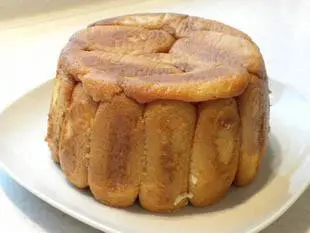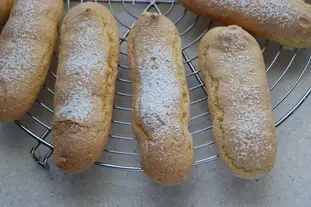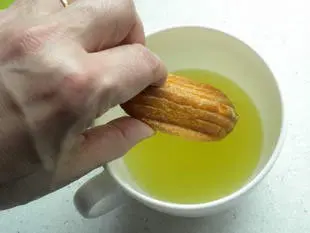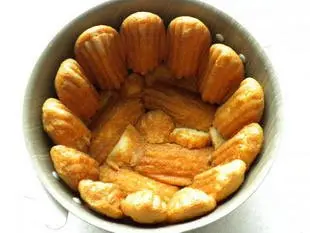This site uses only a few technical cookies necessary for its operation. By continuing to browse, you accept their use.
To find out more...
To find out more...
The art of the charlotte

In cooking, a charlotte is a delicious moulded dessert, with biscuits around the outside that have been soaked in a flavoured syrup, filled with a light cream or mousse. The charlotte is left to set in the fridge before being turned out and served in slices.
It is very light and a lovely sweet with which to round off a meal. It is refreshing, too, especially if made with fruit.
It is very light and a lovely sweet with which to round off a meal. It is refreshing, too, especially if made with fruit.
46 K 4.3/5 (18 reviews)
Keywords for this post:PastryCakeCookiesCreamDessertsCharlotteLast modified on: February 27th 2013
The art of the charlotte
Here are some hints on making charlottes.
A charlotte mould is lined in the bottom and around the sides with syrup-soaked biscuits. This outside layer is then filled with a cream and left to set in the fridge (usually overnight).
Of course, it is best to use a proper charlotte mould if possible. This is round and tall with tapering sides which make turning out easier. If the mould is non-stick, so much the better, as there is no need to butter it.
If you are worried that the charlotte will not turn out properly (it might stick on the bottom and fall apart) you can put a circle of paper or plastic film in the bottom of the mould.
Boudoir or sponge finger biscuits are the ones most commonly used – they are just right for this. If you don't have any, you can use slices of genoa sponge or brioche.
The biscuits are soaked in the syrup until they have absorbed some of it up before being arranged around the sides of the mould. The syrup needs to be well-flavoured and quite runny so that the biscuits can soak it up easily (a fruit coulis, for example, is thicker, so would need a longer soaking time).
Please note that there is a delicate balance to be struck between biscuits that are too dry or too soggy. Personally, when using a very liquid syrup (such as coffee), I soak the biscuit in the syrup, then take it out and remove the excess by pressing.
It is traditional to line the mould with biscuits arranged vertically around the side, then arrange more biscuits in the bottom. Of course, the biscuits won't be the right shape and will need to be cut to fit to give an even layer.
Once the outer "casing" is in place, this is filled with a cream that should set when cold. This is typically made with gelatin or agar-agar. One of the best results comes from using (about 50/50) whipped cream with something else that contains dissolved gelatine. This other ingredient can be a fruit coulis (fruit purée), custard (crème anglaise), creamy cheese like mascarpone, etc.
You can also make the charlotte in different layers: cream, diced fruit, cream. However you fill it, do be sure to fill the mould full, even round the top a little, as the cream will tend to sink a little as it sets.
You can also finish with a layer of biscuits, so that the charlotte has a complete outer shell. This is simply for appearance and a matter of taste.
Once the cream has been poured into the mould, cover with plastic film and leave to set in the fridge overnight.
Shortly before serving, turn out carefully and slice vertically. Serve the slices laid flat for best effect, surrounded by a coulis, sauce or custard if you wish.
The dessert's origins are uncertain. The name might refer to the British queen Charlotte who was the wife of George III.
Principle
A charlotte mould is lined in the bottom and around the sides with syrup-soaked biscuits. This outside layer is then filled with a cream and left to set in the fridge (usually overnight).
Mould

Of course, it is best to use a proper charlotte mould if possible. This is round and tall with tapering sides which make turning out easier. If the mould is non-stick, so much the better, as there is no need to butter it.
If you are worried that the charlotte will not turn out properly (it might stick on the bottom and fall apart) you can put a circle of paper or plastic film in the bottom of the mould.
Biscuits

Boudoir or sponge finger biscuits are the ones most commonly used – they are just right for this. If you don't have any, you can use slices of genoa sponge or brioche.
Soaking syrup

The biscuits are soaked in the syrup until they have absorbed some of it up before being arranged around the sides of the mould. The syrup needs to be well-flavoured and quite runny so that the biscuits can soak it up easily (a fruit coulis, for example, is thicker, so would need a longer soaking time).
Please note that there is a delicate balance to be struck between biscuits that are too dry or too soggy. Personally, when using a very liquid syrup (such as coffee), I soak the biscuit in the syrup, then take it out and remove the excess by pressing.

It is traditional to line the mould with biscuits arranged vertically around the side, then arrange more biscuits in the bottom. Of course, the biscuits won't be the right shape and will need to be cut to fit to give an even layer.
Cream filling

Once the outer "casing" is in place, this is filled with a cream that should set when cold. This is typically made with gelatin or agar-agar. One of the best results comes from using (about 50/50) whipped cream with something else that contains dissolved gelatine. This other ingredient can be a fruit coulis (fruit purée), custard (crème anglaise), creamy cheese like mascarpone, etc.
You can also make the charlotte in different layers: cream, diced fruit, cream. However you fill it, do be sure to fill the mould full, even round the top a little, as the cream will tend to sink a little as it sets.
You can also finish with a layer of biscuits, so that the charlotte has a complete outer shell. This is simply for appearance and a matter of taste.
Once the cream has been poured into the mould, cover with plastic film and leave to set in the fridge overnight.
Shortly before serving, turn out carefully and slice vertically. Serve the slices laid flat for best effect, surrounded by a coulis, sauce or custard if you wish.
Charlotte?

The dessert's origins are uncertain. The name might refer to the British queen Charlotte who was the wife of George III.
Lasts posts
Oven height
When we put a dish or cake in the oven, we naturally tend to put it on the middle shelf, and that's what we usually do. But in some cases, this position and height can be a little tricky, so let's find out why.October 8th 20251,9415
The importance of sieving
In recipes that use a fine powder (flour, powdered sugar, etc.), you'll often see the advice to sift before using it. To sift is to pass the powder in question through a sieve (a very fine strainer) before incorporating it into your recipe. It's often advice, but is it really useful?September 3rd 20257,1013
The grease spray
As soon as you have something in a recipe that sticks to the mold, the question always arises as to how difficult it is to remove from the mold. There's nothing more frustrating than breaking your cake when unmolding it, because part of it has stuck in the mold. The classic way to avoid this is...August 26th 20256,5835
Cake moulds
When we make a cake, or a cake of the same rectangular shape, we usually take out our usual mould and tell ourselves that the recipe is anyway "for a cake", but is it really that simple?August 25th 20256,6585
Thinning out herbs
If you need to add a long-stemmed herb (tarragon, mint, verbena, thyme, etc.) to a recipe, you'll probably only need the leaves and not the stem, so you'll need to remove the leaves. Leaf removal means keeping only the beautiful leaves, and eliminating the ugly stems and leaves, but how do you do...August 8th 20254,7765
Other pages you may also like
Drawing a pattern in pastry
Often in the kitchen, in pastry-making, or in baking, we need to trace a pattern on a pastry. It's just a question of aesthetics but it has its effect after baking on a galette, pithiviers, pâté en croute (terrine in a pie crust), etc.May 23th 201934 K4.1
Tranché, dissociated, failed, in short... missed!
When preparing a sauce or a cream, there's always a (small) risk that the creamy preparation you're working on will suddenly separate into two parts of different textures: a liquid part, for example, and a more or less solid part, or even become lumpy. It's terribly frustrating, but we'll see...June 19th 202312 K5
Different kinds of pastry and dough
When cooking in general, and particularly in baking, we can make and use many different kinds of pastry and dough. All built on the same "base": flour - a powder to which we add fat, liquid or both to produce the dough which is then cooked. .November 6th 2012111 K 14.0
Fruits which can ruin your jelly
There are many ways of making a fruit mousse, but one of the simplest is to prepare a fruit jelly (basically a fresh fruit coulis with gelatine) and then mix this jelly before it sets completely with whipped cream. The result is perfect for filling a charlotte, for example. But do beware;...March 6th 201378 K4.0
Steam for baking bread
What does steam have to do with bread-making? This is not only a bakers' secret, it is something you might not think of at all: if you make bread and bake it like a cake, you will end up with bread, but pale and with a thick, hard crust – a long way from the golden-brown crusty loaf you had in...June 16th 2021146 K4.5
Post a comment or question
Follow this page
If you are interested in this page, you can "follow" it, by entering your email address here. You will then receive a notification immediately each time the page is modified or a new comment is added. Please note that you will need to confirm this following.
Note: We'll never share your e-mail address with anyone else.
Alternatively: you can subscribe to the mailing list of cooling-ez.com , you will receive a e-mail for each new recipe published on the site.









